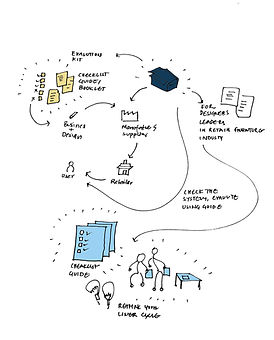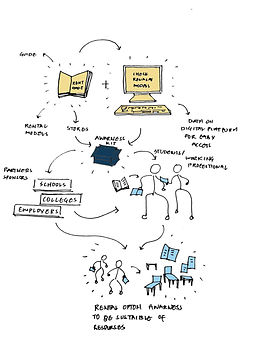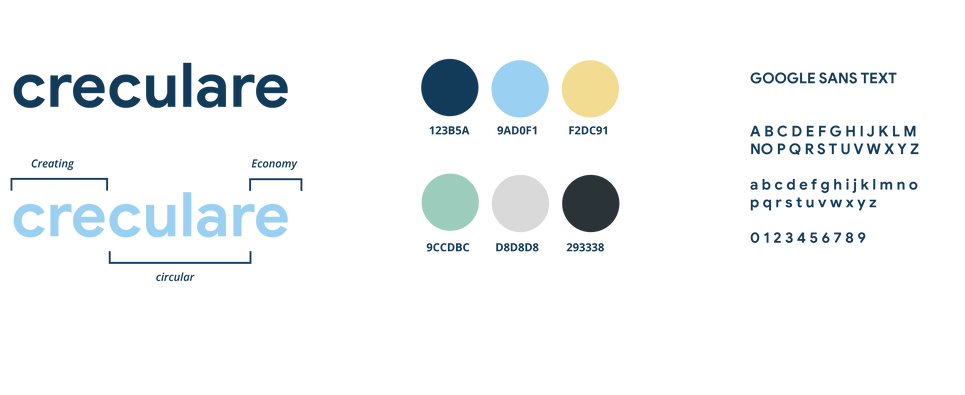
Creculare Toolkit
The aim of this project is to use design management methods that can help innovators in the furniture industry to create circular sustainable products, services, and systems that satisfy both needs of people’s temporary lifestyle and a move towards a circular business model.
As my final project, I designed a toolkit to run creative and collaborative workshops to create future ideas for sustainable furniture products based on the principle of the circular economy.
Role
Product Designer + Strategist, SCAD
Timeline
Mar-May 2020
Tools
Figma, Survey Monkey, Adobe Suite, Google Suite
creculare

A toolkit to run creative and collaborative workshops to create future ideas for sustainable furniture products/services/system based on the principle of the circular economy
creculare
CARDS 01
Research findings were collected and summarized into trigger cards, which will be used for the conception of future scenarios and stories

The guide provides a circular design framework and facilitation plans which will take designers and business leaders through a step-by-step the process to understand the circular economy and develop sustainable ideas for their own companies
creculare
GUIDE 02


creculare
SHEET 03
The following worksheets will keep track of all ideas and help to map different concept elements to identify gaps and opportunities. It will also help teams to engage with other ideas and foster a creative exchange

Temporary lifestyle increasing wastage of furniture and resources
Problem
The lives of people in western countries like the United States are extremely mobile as there is a constant need to relocate from point A to B due to changes in work, education, or personal reasons. 35.5 million American moves each year refurbishing their house and 15 million tonne furniture goes into landfills which are excessive usages and wastage of resources. This linear pattern is extremely wasteful and unsustainable.
Create a system that suits the needs of people with a temporary lifestyle and adapt to sustainable consumption
Design Challenge
Help innovators in the furniture industry to create circular sustainable products, services, and systems that satisfy both needs of people’s temporary lifestyle and a move towards a circular business model.
A toolkit to run creative and collaborative workshops to create future ideas for sustainable furniture products based on the principle of the circular economy
Solution
SECONDARY
RESEARCH
Using key facts as a tool to find out more data regarding sustainable consumption, I discovered that we are in a moment when our resource consumption is pushing us towards planetary boundaries, there is an opportunity to re-imagine how businesses, products, and services are designed, experienced and valued.
BY
2030
LIMITED RESOURCES
FURNITURE
BRANDS
1
TRILLION
USD
prediction made at the 2017 WorldEconomic Forum was that by 2030 individuals would no longer own anything
that resources are limited so
we must find smarter ways to
use them
are responding to continuing rise of collaborative consumption by designing products that appeal to
multiple temporary users rather than to a single owner
World Economic Forum puts the potential worldwide economic benefit of the circular economy at one trillion USD annually
MARKET
ANALYSIS
The market analysis gave me an overview of companies, who are into retailing/manufacturing of furniture and household products, and also organizations that are providing tools and methods to implement principles of a circular economy to the business. After mapping the competitors, I did a collaborator analysis and 2X2 of the competitors to understand their network and opportunities for collaboration.



USER RESEARCH
METHODOLOGY
76%
SURVEY
RESULTS
60%
74%
64%
respondents have preferred platform to look for house is online marketplace with remaining using Zillow
NEW BUY
responded has bought
most of their furniture and
household products when
they moved
STRUGGLE
responded struggle while
reselling their furniture and
household products
DISOWNERSHIP
responded that furniture
ownership is not that important to them, they just want to use them temp
IN-DEPTH
INTERVIEWS
“(.......worry if it will be sold)”
“(....hassle a lot with buying
furniture while changing homes)”
“(....Yes, I would want an easy way to buy and
return without throwing the item”
“(...“ Eventually, all industries will need to move
towards sustainable circular model ”)”
“(....Sometimes I throw my furniture away if I don’t find a buyer)”
“(I would resell my items if the store where I bought
offered a convenient buyback program)”
“(...we do not have a formal
program for rental furniture)”
An affinity map was created with quotations from the interviews to look for patterns and gain deeper insights into the target audiences. The research created various visual models, including best quotes cloud, an affinity map, empathy maps, personas, and a journey map, which served to organize and re-structure the research data
AFFINITY
MAPPING

EMPATHY MAPS
& PERSONAS




USER
JOURNEY
KEY
INSIGHTS


INEFFICIENT
INCONVENIENT
Furniture ownership is not flexible when it comes to moving to a new house. Users wants flexibility, which best fits their plans. Temporary
living conditions raise demand for more flexibility and rapid turnover in terms of consumption and ownership.
The existing system of buying and reselling furniture for temporary time is not convenient and easy for the users. Other users bought from retailers, though they were able to find the item easily,transportation of the furniture is not very convenient for them.

EXPENSIVE
Users do not want to invest a lot in furniture where they know that they will only use a certain period. However, the users find existing system expensive. Users buy cheap, with a giveaway mindset, in case they do not find a buyer.Not being able to resell the furniture makes users lose a lot of money in the process.

DISOWNERSHIP
The end of a product’s life is often not caused by disfunction but changes
in the living conditions of people.Most of the users see no necessity to express their individuality with the furniture in their certain life situations.

FLEXIBLITY
Furniture ownership is not flexible when it comes to moving to a new house. Users wants flexibility, which best fits their plans. Rooted in uncertainty, users cannot plan in long terms. Temporary living conditions raise demand for
more flexibility and rapid turnover in terms of consumption and ownership.

AWARENESS
Most of the consumers lack
awareness of rental housing, existing furniture rental services, circular product models and means to engage in circular behaviors.Lack of awareness leads users to choose to live in a shared rented flat and buy second hand - low-quality furniture on which they eventually end up spending
a lot of money.

SUSTAINABLE
The gap between intentions and
actions lead to unsustainable
consumption behavior. The majority of the users are environmentally conscious
about their actions. However, often actions do not follow their intentions caused, by time, place, emotions and budget

OPPORTUNITY TO
DESIGN MATRIX
DESIGN
CRITERIA
The research, findings, and insights were formed into three categories: mindset, motive, and need. These three elements became the key factors in the design criteria that need to be addressed while design development. The design should help to create a more flexible way of living which means that it should respect and encourage the lifestyle of millennials who are temporarily living in the United States. It also should be adding value at the end of a product’s life cycle that would prevent users from being wasteful and encourage them to step out of unsustainable consumption. The solution should see products (furniture) as part of a system that is designed around loops and cycles where products float back into a system that encourages re-usability and preservation of resources.
Guidelines for innovators in furniture and household products industry to evaluate the existing system
Encouraging partnership and collaboration for circular practice
Guidelines for innovators in furniture and household products industry to evaluate the existing system
Help to create a more flexible way of living
Guide and support for being more sustainable on the principle of circular economy
Be easily accessible for innovators and designers in the furniture and household product retail industry
The problem space around the sustainable consumption of resources during the temporary lifestyle of millennials can now be narrowed down to millennial’s do not have enough sustainable options to pick from during their temporary living. The focus is needed to use an existing system where the circular guide can be implemented to address the overall problem, which might lead to the conception of impactful solutions
DIVERSE
CONCEPTS
INEFFICIENT
IN-
CONVENIENT
EXPENSIVE
AWARENESS
DIS-
OWNERSHIP
SUSTAINABLE
FLEXIBILITY



EVALUATION OF EXISTING SYSTEM
AWARENESS FOR
RENTAL MODELS
WORKSHOPS FOR
CIRCULAR PRACTICE
An evaluation guide for furniture retailers to apply in their design process and evaluate the existing buying and selling process to understand consumers need and respond to the need to improve the existing system
Awareness handbook to enlighten consumers for better options, existing rental models and stores based on their situation which would reflect sustainable consumption in their usage of resources
Co-creation workshop toolkit to enable
furniture circular economic venture,
partnerships, and programs for innovators in furniture and household product industry and convert their existing business model into a circular business model




PMI
ANALYSIS
TOOLKIT
DEVELOPMENT
A workshop together with aspiring innovators, designers, business leaders, and sustainability leaders in furniture and household products industry can be conducted to create ideas and identify potential future scenarios. The toolkit is divided into five phases to help aspiring innovators understand and practice circular design. The phases include trigger cards, concept creation, circular cycle, concept selection, and concept opportunities. The phases will support the innovation and collaboration abilities for aspiring innovators to enable sustainable options for millennials and move towards a circular business model.



creculare
CARDS /
Research findings were clustered and condensed into trigger cards, which will be used for the creation of future scenarios and stories. To foster innovation for the creation of future scenarios during the workshop, the following trigger cards will be provided. The cards represent crucial /findings from past research in the areas of Scenario ( What people need?), Initiative (What actions can we take?), and Placement (Where can we provide?). Each card says one word, a summary and a ‘What if..’ question
creculare
GUIDE & WORKSHEETS /
Along with trigger cards, a set of worksheets will be provided. The worksheets guide to generating concepts and narrow down to feasibility. The following worksheets will keep track of all ideas and help to map different concept elements to identify gaps and opportunities. It will also help designers to engage with other ideas and foster a creative exchange.


PROTOTYPE
TESTING
Testing was conducted with a designer and business leader from Wayfair on May 06, 2020, and with one design management students on May 08, 2020. Each participant was provided with an overview of the project, the toolkit - trigger cards, and worksheets.
15-20 minutes were allotted for review of the prototype materials. Concept testing of the prototypes primarily focused on the toolkit, which contains the guidelines to conduct circular design workshops. The working wall shows the resulting marked-up test pages, as well as “pink” sticky notes showing comments derived from post-review discussions with reviewers.
+
Interactive and collaborative toolkit to encourage circular design methods
+
Trigger cards developed from the research insights add value and gamification to the toolkit
+
The phases are easy to understand and transition to develop circular ideas
+
Will give a new approach of circular design to the furniture and household product industry


-
Relation of circular economy and furniture and household product industry
-
Rethink product journey section on ideas capture
(phase 2)
-
Relation of circular economy and furniture and household product industry
-
Detailed design for facilitation plan of circular design workshops
-
Branding needs to be done - reflect circularity


BRAND
IDENTITY
I developed my brand identity which could further, be used to create an overall brand look and feel. of the toolkit. The name “creculare” is inspired by the notion and purpose of the toolkit of creating a circular economy

What I learned
Realignment: The project helped me understand my ability as a design researcher and strategist. I was assuming a different culture at its core issue with several other judgments, but retaining the purpose of understanding and being unbiased helped me identify not just a secure problem area but also a solution that could make a difference. The research process was challenging as I had constant learning from different stakeholders throughout the project.
COVID-19 did affect the design approach, but I was able to identify my ability to shift and find a solution by conducting the virtual workshop. As I progressed towards a design solution that was more fulfilling through the toolkit, I learned how to make a toolkit prototype and eventually make it as a final deliverable within three weeks. This project challenged me but made me a flexible and robust designer who can find the best possible solution to any problem within a limited time frame.